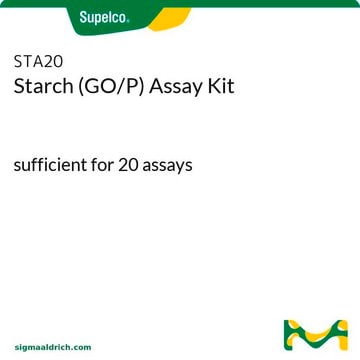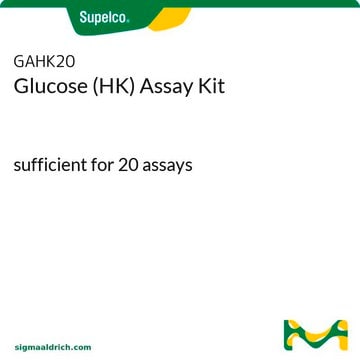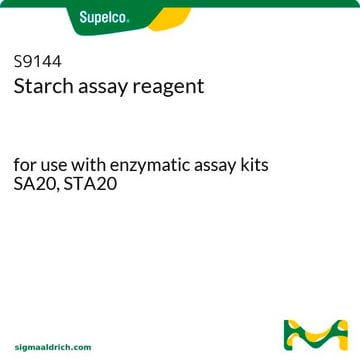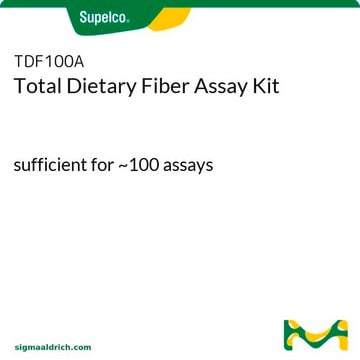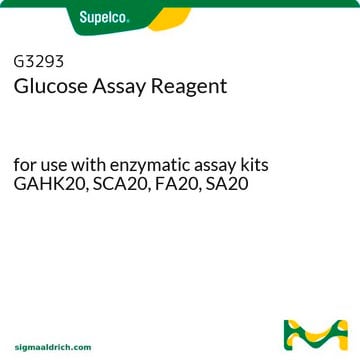SA20
Starch (HK) Assay Kit
sufficient for 20 assays
Synonym(s):
Starch Quantitation Kit
Sign Into View Organizational & Contract Pricing
All Photos(1)
About This Item
UNSPSC Code:
12164500
NACRES:
NA.84
Recommended Products
usage
sufficient for 20 assays
analyte chemical class(es)
sugars
technique(s)
photometry: suitable
application(s)
food and beverages
general analytical
storage temp.
2-8°C
Application
This kit is for the quantitative, enzymatic determination of native starch in food and other materials using the amyloglucosidase-hexokinase-glucose 6-phosphate dehydrogenase enzymatic assay. The hydrolysis of starch to glucose is catalyzed by amyloglucosidase. Glucose is phosphorylated by adenosine triphosphate (ATP) in the reaction catalyzed by hexokinase. Glucose-6-phosphate (G6P) is then oxidized to 6-phosphogluconate in the presence of nicotinamide adenine dinucleotide (NAD) in a reaction catalyzed by glucose-6-phosphate dehydrogenase (G6PDH). During this oxidation, an equimolar amount of NAD is reduced to NADH. The increase in absorbance at 340 nm is directly proportional to the glucose concentration.
Kit Components Only
Product No.
Description
- glucose assay reagent 20 mL
- starch assay reagent 1 mL/vial
- starch assay standard 5 g
related product
Product No.
Description
Pricing
Signal Word
Warning
Hazard Statements
Precautionary Statements
Hazard Classifications
Eye Irrit. 2 - Skin Irrit. 2 - STOT SE 3
Target Organs
Respiratory system
Storage Class Code
11 - Combustible Solids
Certificates of Analysis (COA)
Search for Certificates of Analysis (COA) by entering the products Lot/Batch Number. Lot and Batch Numbers can be found on a product’s label following the words ‘Lot’ or ‘Batch’.
Already Own This Product?
Find documentation for the products that you have recently purchased in the Document Library.
Customers Also Viewed
Zhongqi He et al.
Molecules (Basel, Switzerland), 27(1) (2022-01-12)
Common "glanded" (Gd) cottonseeds contain the toxic compound gossypol that restricts human consumption of the derived products. The "glandless" (Gl) cottonseeds of a new cotton variety, in contrast, show a trace gossypol content, indicating the great potential of cottonseed for
Guangrong Hu et al.
PloS one, 8(4), e60700-e60700 (2013-04-18)
The unicellular green microalga Desmodesmus sp. S1 can produce more than 50% total lipid of cell dry weight under high light and nitrogen-limitation conditions. After irradiation by heavy (12)C(6+) ion beam of 10, 30, 60, 90 or 120 Gy, followed
M Djanaguiraman et al.
Plant, cell & environment, 41(5), 993-1007 (2017-02-09)
The objectives were to (1) quantify high temperature (HT) stress impacts at different growth stages (season long, booting to seed-set and booting to maturity) on various yield components; (2) identify the most sensitive stage(s) to short episodes of HT stress
FarhanaR Bhuiyan et al.
Journal of proteomics, 214, 103632-103632 (2020-01-01)
The fruit physiology of banana cultivars other than Cavendish is poorly understood. To study the ripening process, samples were taken daily from plantain and Cavendish bananas and the ripening stages were determined. We present data from the green to the
B Degrenne et al.
Biotechnology and bioengineering, 108(10), 2288-2299 (2011-04-27)
Photosynthetic hydrogen production under light by the green microalga Chlamydomonas reinhardtii was investigated in a torus-shaped PBR in sulfur-deprived conditions. Culture conditions, represented by the dry biomass concentration of the inoculum, sulfate concentration, and incident photon flux density (PFD), were
Our team of scientists has experience in all areas of research including Life Science, Material Science, Chemical Synthesis, Chromatography, Analytical and many others.
Contact Technical Service